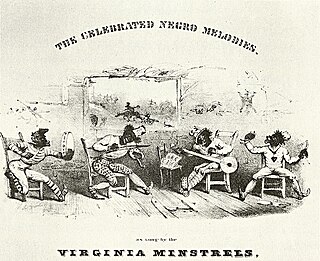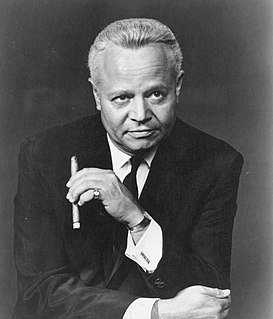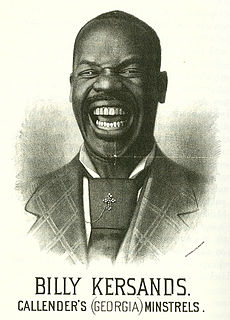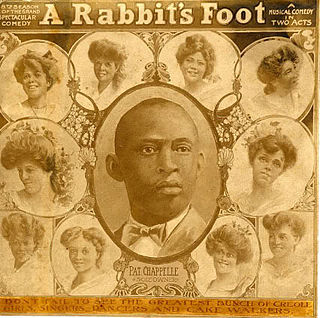Related Research Articles

Blackface is a term which is used to describe a form of theatrical make-up which is predominantly used by non-black performers in order to represent a caricature of a black person. The term is also used in reference to black makeup, which is worn as part of folk tradition and disguising rather than as a racial stereotype of black people.

The Black and White Minstrel Show was a popular British light entertainment show that ran for twenty years on BBC prime-time television. Beginning in 1958, it was a weekly variety show which presented traditional American minstrel and country songs, as well as show tunes and music hall numbers, lavishly costumed. It was also a successful stage show which ran for ten years from 1962 to 1972 at the Victoria Palace Theatre, London. This was followed by tours of UK seaside resorts, together with Australia and New Zealand.

The minstrel show, or minstrelsy, was an American form of entertainment developed in the early 19th century. Each show consisted of comic skits, variety acts, dancing, and music performances that depicted people specifically of African descent. The shows were performed by mostly white people in make-up or blackface for the purpose of playing the role of black people. There were also some African-American performers and black only minstrel groups that formed and toured. Minstrel shows lampooned black people as dim-witted, lazy, buffoonish, superstitious, and happy-go-lucky.

In Living Color is an American sketch comedy television series that originally ran on Fox from April 15, 1990 to May 19, 1994. Keenen Ivory Wayans created, wrote and starred in the program. The show was produced by Ivory Way Productions in association with 20th Television and was taped at stage 7 at the Fox Television Center on Sunset Boulevard in Hollywood, California.
William Edward Cotton as Billy Cotton was an English band leader and entertainer, one of the few whose orchestras survived the British dance band era. Cotton is now mainly remembered as a 1950s and 1960s radio and television personality, but his musical career had begun in the 1920s. In his younger years Billy Cotton was also an amateur footballer for Brentford, an accomplished racing driver and the owner of a Gipsy Moth, which he piloted himself. His autobiography, I Did It My Way, was published in 1970, a year after his death.

Master Juba was an African-American dancer active in the 1840s. He was one of the first black performers in the United States to play onstage for white audiences and the only one of the era to tour with a white minstrel group. His real name was believed to be William Henry Lane, and he was also known as "Boz's Juba" following Dickens's graphic description of him in American Notes.

The Virginia Minstrels or Virginia Serenaders was a group of 19th-century American entertainers who helped invent the entertainment form known as the minstrel show. Led by Dan Emmett, the original lineup consisted of Emmett, Billy Whitlock, Dick Pelham, and Frank Brower.

William Boone Daniels, better known as Billy Daniels, was an American singer active in the United States and Europe from the mid-1930s to 1988, notable for his hit recording of "That Old Black Magic" and his pioneering performances on early 1950s television. He was one of the first African-American entertainers to cross over into the mainstream. Daniels was honored with a star on the Hollywood Walk of Fame in 1977.

Thomas Dilward (1840–1887), also known by the stage name Japanese Tommy, was an African-American dwarf who performed in blackface minstrel shows. He was also sometimes billed as "The African 'Tom Thumb'" and the "African Dwarf Tommy".

Christopher Haverly (1837–1901), better known as J. H. Haverly or John H. "Jack" Haverly, was an American theatre manager and promoter of blackface minstrel shows. During the 1870s and 1880s, he created an entertainment empire centered on his minstrel troupes, particularly Haverly's United Mastodon Minstrels and Haverly's Colored Minstrels. Under his guidance, these troupes grew to impressive sizes and featured elaborate sets and costumes. They toured widely, enlarging minstrelsy's audience to encompass the entire United States as well as England. Haverly's methods sparked a revolution in minstrelsy as other troupes scrambled to compete. As the costs of minstrelsy increased, many troupes went out of business.

Billy Kersands was an African-American comedian and dancer. He was the most popular black comedian of his day, best known for his work in blackface minstrelsy. In addition to his skillful acrobatics, dancing, singing, and instrument playing, Kersands was renowned for his comic routines involving his large mouth, which he could contort comically or fill with objects such as billiard balls or saucers. His stage persona was that of the dim-witted black man of the type that had been popularized in white minstrel shows. Modern commentators such as Mel Watkins cite him as one of the earliest black entertainers to have faced the dilemma of striking a balance between social satire and the reinforcement of negative stereotypes.

Hokum is a particular song type of American blues music—a humorous song which uses extended analogies or euphemistic terms to make sexual innuendos. This trope goes back to early blues recordings and is used from time to time in modern American blues and blues rock.

Francis Marion Brower was an American blackface performer active in the mid-19th century. Brower began performing blackface song-and-dance acts in circuses and variety shows when he was 13. He eventually introduced the bones to his act, helping to popularize it as a blackface instrument. Brower teamed with various other performers, forming his longest association with banjoist Dan Emmett beginning in 1841. Brower earned a reputation as a gifted dancer. In 1842, Brower and Emmett moved to New York City. They were out of work by January 1843, when they teamed up with Billy Whitlock and Richard Pelham to form the Virginia Minstrels. The group was the first to perform a full minstrel show as a complete evening's entertainment. Brower pioneered the role of the endman.

The Rabbit's Foot Company, also known as the Rabbit('s) Foot Minstrels and colloquially as "The Foots", was a long-running minstrel and variety troupe that toured as a tent show in the American South between 1900 and the late 1950s. It was established by the African-American entrepreneur Pat Chappelle and taken over after his death in 1911 by Fred Swift Wolcott. It provided a basis for the careers of many leading African-American musicians and entertainers, including Arthur "Happy" Howe, Ma Rainey, Ida Cox, Bessie Smith, Butterbeans and Susie, Tim Moore, Big Joe Williams, Louis Jordan, Brownie McGhee, Rufus Thomas, and Charles Neville.

Jimmy James was a music hall, film, radio and television comedian and comedy actor. James had limited use for jokes as such, preferring to say things in a humorous manner, sometimes in surreal situations and as such was seen by some as well ahead of his time. He was often hailed as a "comedians' comedian".
Christmas Night with the Stars was a television show broadcast each Christmas night by the BBC from 1958 to 1972. The show was hosted each year by a leading star of BBC TV and featured specially made short seasonal editions of the previous year's most popular BBC sitcoms and light entertainment programs. Most of the variety segments no longer exist in accordance with the BBC's policy of wiping at the time, prevalent into the late 1970s.
Perri Lister is an English former dancer, singer and actress. She was a dancer with the British dance troupe Hot Gossip which appeared regularly on The Kenny Everett Video Show in the late 1970s – early 1980s in the United Kingdom. In the 1980s Lister was a backing vocalist for a number of pop music acts, including Billy Idol, with whom she had a nine-year relationship.
Brian Tesler is a British television producer and executive. His career encompassed British television's post-war evolution from a single-channel BBC to the beginning of today’s multitude of cable and satellite channels. He worked as a producer for Independent Television, as well as the BBC.

The Marquis Chimps were a group of trained chimpanzees that were used in variety shows and television programmes and commercials, initially in Britain and then in the United States, from the late 1940s to the 1980s. They were owned and trained by Gene Detroy.
Donald Angus Campbell, known professionally as Don Arrol, was a Scottish comedian and television variety show entertainer.